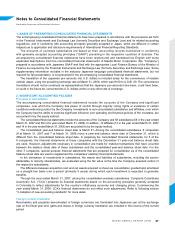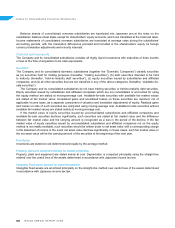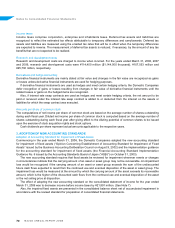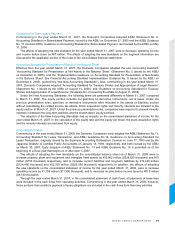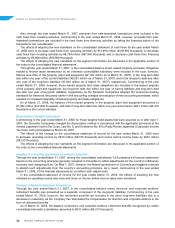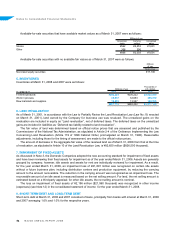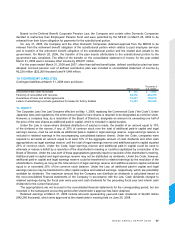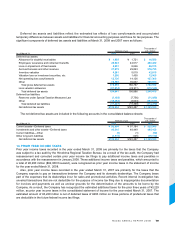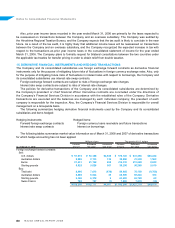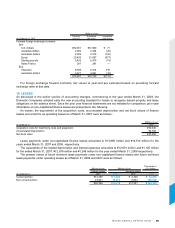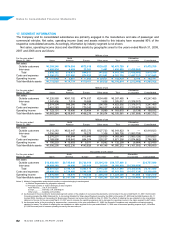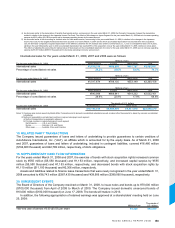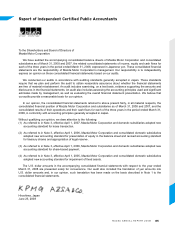Mazda 2008 Annual Report Download - page 79
Download and view the complete annual report
Please find page 79 of the 2008 Mazda annual report below. You can navigate through the pages in the report by either clicking on the pages listed below, or by using the keyword search tool below to find specific information within the annual report.
Based on the Defined Benefit Corporate Pension Law, the Company and certain other Domestic Companies
decided to restructure their Employees’ Pension Fund and were permitted by the MHLW on March 26, 2004 to be
released from their future obligation for payments for the substitutional portion.
On July 31, 2005, the Company and the other Domestic Companies obtained approval from the MHLW to be
relieved from the retirement benefit obligation of the substitutional portion which relates to past employee services
and to transfer of the retirement benefit obligation of the substitutional portion and the related plan assets to the
government. On March 28, 2006, the transfer of the plan assets attributable to the substitutional portion to the
government was completed. The effect of the transfer on the consolidated statement of income for the year ended
March 31, 2006 was to increase other income by ¥59,611 million.
For the years ended March 31, 2008 and 2007, other than defined benefit plan, defined contribution plan has been
adopted. Accrued pension cost of defined contribution plan was included in consolidated statement of income by
¥2,226 million ($22,260 thousand) and ¥1,949 million.
10. CONTINGENT LIABILITIES
Contingent liabilities at March 31, 2008 were as follows:
Thousands of
Millions of yen U.S. dollars
Discounted trade notes receivable ¥ 183 $ 1,830
Factoring of receivables with recourse 22,372 223,720
Guarantees of loans and similar agreements 10,381 103,810
Letters of undertaking to provide guarantees for leases for factory facilities 15,233 152,330
11. EQUITY
The Corporate Law (“the Law”) became effective on May 1, 2006, replacing the Commercial Code (“the Code”). Under
Japanese laws and regulations, the entire amount paid for new shares is required to be designated as common stock.
However, a company may, by a resolution of the Board of Directors, designate an amount not exceeding one half of
the price of the new shares as additional paid-in capital, which is included in capital surplus.
Under the Law, in cases where dividend distribution of surplus is made, the smaller of an amount equal to 10%
of the dividend or the excess, if any, of 25% of common stock over the total of additional paid-in capital and legal
earnings reserve, must be set aside as additional paid-in capital or legal earnings reserve. Legal earnings reserve is
included in retained earnings in the accompanying consolidated balance sheets. Under the Code, companies were
required to set aside an amount equal to at least 10% of the aggregate amount of cash dividends and other cash
appropriations as legal earnings reserve until the total of legal earnings reserve and additional paid-in capital equaled
25% of common stock. Under the Code, legal earnings reserve and additional paid-in capital could be used to
eliminate or reduce a deficit by a resolution of the shareholder’s meeting or could be capitalized by a resolution of the
Board of Directors. Under the Law, both of these appropriations generally require a resolution of the shareholder’s meeting.
Additional paid-in capital and legal earnings reserve may not be distributed as dividends. Under the Code, however,
additional paid-in capital and legal earnings reserve could be transferred to retained earnings by the resolution of the
shareholder’s meeting as long as the total amount of legal earnings reserve and additional paid-in capital remained
equal to or exceeded 25% of the common stock balance. Under the Law, all additional paid-in capital and legal
earnings reserve may be transferred to other capital surplus and retained earnings, respectively, which are potentially
available for dividends. The maximum amount that the Company can distribute as dividends is calculated based on
the non-consolidated financial statements of the Company in accordance with the Law. Cash dividends charged to
retained earnings during the fiscal year were year-end cash dividends for the preceding fiscal year and interim cash
dividends for the current fiscal year.
The appropriations are not accrued in the consolidated financial statements for the corresponding period, but are
recorded in the subsequent accounting period after shareholder’s approval has been obtained.
Retained earnings at March 31, 2008 include amounts representing year-end cash dividends of ¥4,228 million
($42,280 thousand), which were approved at the shareholder’s meeting held on June 25, 2008.


